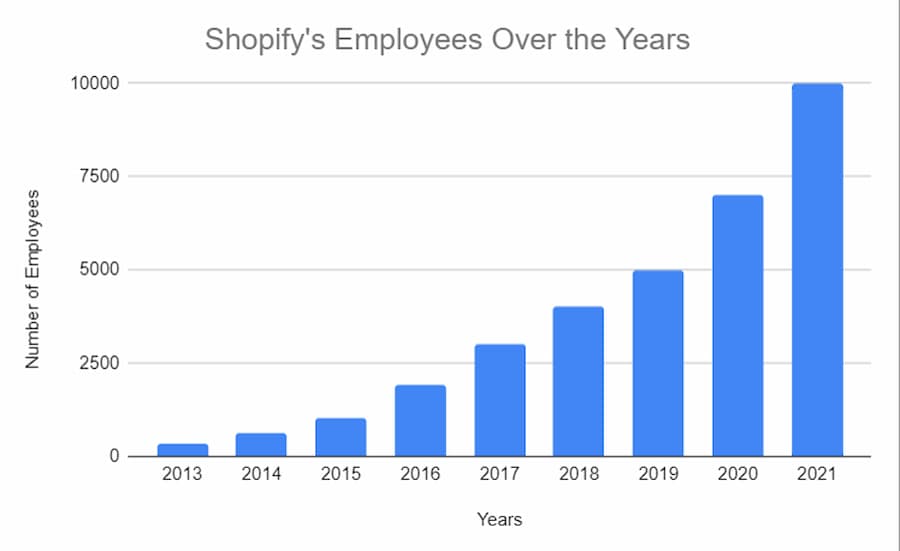Shopify's Lifetime Revenue Model: Impact On Developer Earnings

Table of Contents
Understanding Shopify's Recurring Revenue Model
The core of Shopify's success, and a key factor influencing developer income, is its recurring revenue model. This means developers earn money not just from a one-time sale, but through ongoing monthly or annual subscriptions for their apps and themes. This differs significantly from traditional software sales models, offering a more predictable and potentially exponentially growing income stream.
Imagine a simple scenario: you create a monthly subscription app that costs $1 per user. If you acquire 1000 users, your monthly recurring revenue is $1000. This is a significant advantage over a one-time purchase model where your income is limited to the initial sale.
- Predictable Income Stream: Recurring subscriptions provide a stable, predictable income flow, allowing for better financial planning and business management.
- Exponential Growth Potential: As your user base expands, so does your revenue, creating the potential for significant growth without needing to constantly sell new copies of your product.
- Ongoing Maintenance and Updates: To retain subscribers, continuous maintenance, updates, and feature additions are crucial. This is an ongoing investment of time and resources but is essential for long-term success.
- Impact of Churn Rate: The churn rate (the percentage of subscribers who cancel their subscriptions) significantly impacts overall earnings. Strategies to reduce churn are vital for maximizing revenue from Shopify's lifetime revenue model.
Analyzing the Shopify App Store's Revenue Share
Shopify's App Store operates on a revenue-sharing model, typically an 80/20 split, where developers receive 80% of the revenue generated by their apps and themes, while Shopify takes the remaining 20%. This revenue share is crucial to understanding your net income. Several factors influence the developer's net revenue:
- Understanding the Breakdown of Fees and Charges: It’s crucial to thoroughly understand all associated fees and charges, including transaction fees, payment processing fees, and any other deductions before calculating your actual take-home earnings.
- Strategies for Maximizing Revenue: Strategies like strategic pricing, effective marketing within the App Store, and offering premium features or add-ons can significantly impact your revenue share.
- Competition within the App Store: The Shopify App Store is competitive. Understanding your competition, analyzing their pricing and features, and differentiating your app through unique value propositions is vital for success.
- Importance of App Store Optimization (ASO): ASO is critical for increasing visibility and driving downloads. Keywords, app descriptions, and screenshots all play a crucial role in attracting potential customers.
The Role of Customer Lifetime Value (CLTV) in Developer Earnings
Customer Lifetime Value (CLTV) represents the total revenue a single customer is expected to generate throughout their relationship with your app. In the context of Shopify apps, this is crucial for long-term profitability within Shopify's lifetime revenue model.
Increasing CLTV involves focusing on customer retention and satisfaction. This can be achieved through:
- Strategies for Improving Customer Retention: Proactive customer support, regular updates, valuable features, and a strong community can all help reduce churn and improve customer retention.
- Importance of Building Strong Customer Relationships: Engaging with your customers, actively soliciting feedback, and building a loyal community can lead to higher CLTV and increased word-of-mouth referrals.
- The Long-Term Impact of High CLTV: A high CLTV significantly improves the predictability and stability of your earnings, allowing for sustainable growth and investment in your app's development.
- Tools and Techniques for Calculating and Tracking CLTV: Several tools and techniques exist for calculating and tracking CLTV. Regular monitoring of CLTV allows you to assess the effectiveness of your retention strategies and identify areas for improvement.
Challenges and Opportunities within Shopify's Revenue Model
While Shopify's lifetime revenue model offers fantastic potential, it's not without its challenges:
- Competition: The Shopify App Store is a crowded marketplace. Standing out requires innovation, effective marketing, and a strong value proposition.
- Marketing Costs: Acquiring new customers requires investment in marketing and advertising. Understanding your customer acquisition cost (CAC) and ensuring it's lower than your CLTV is essential.
- Maintaining App Quality: Ongoing maintenance, bug fixes, and security updates are crucial for maintaining customer satisfaction and retaining subscriptions.
However, significant opportunities also exist:
- Niche Markets: Focusing on a specific niche can reduce competition and allow you to build a strong, loyal customer base.
- Innovative Apps: Developing innovative apps that solve real problems for Shopify merchants can create a significant competitive advantage.
- Strategic Partnerships: Collaborating with other Shopify developers or agencies can expand your reach and increase your customer base.
The need for continuous learning and adaptation to market changes is paramount. Effective marketing and customer acquisition strategies are essential for success. Exploring different monetization models beyond subscriptions, such as freemium models or one-time purchases for add-ons, can also diversify your income streams. Building a strong brand and community around your apps is key to long-term success and loyalty.
Conclusion
Shopify's lifetime revenue model presents both significant opportunities and challenges for developers. While the recurring revenue potential is attractive, success requires a strategic approach to app development, marketing, and customer retention. Understanding the nuances of the Shopify App Store revenue share, maximizing Customer Lifetime Value, and navigating the competitive landscape are crucial for developers seeking to build profitable and sustainable businesses.
Ready to optimize your earnings within Shopify's lifetime revenue model? Learn more about maximizing your profits and building a thriving Shopify app business today! Dive deeper into strategies to boost your income from Shopify's lifetime revenue model.

Featured Posts
-
 Ufc Des Moines Fight By Fight Predictions And Betting Odds
May 04, 2025
Ufc Des Moines Fight By Fight Predictions And Betting Odds
May 04, 2025 -
 Is The Count Of Monte Cristo Still Relevant Today A Detailed Review
May 04, 2025
Is The Count Of Monte Cristo Still Relevant Today A Detailed Review
May 04, 2025 -
 Fans Analyze Anna Kendricks Body Language In Blake Lively Interview
May 04, 2025
Fans Analyze Anna Kendricks Body Language In Blake Lively Interview
May 04, 2025 -
 Shopify Developer Program Changes A Breakdown Of The New Revenue Share
May 04, 2025
Shopify Developer Program Changes A Breakdown Of The New Revenue Share
May 04, 2025 -
 Tournage De L Age D Or Premier Film Realise Par Berenger Thouin
May 04, 2025
Tournage De L Age D Or Premier Film Realise Par Berenger Thouin
May 04, 2025
